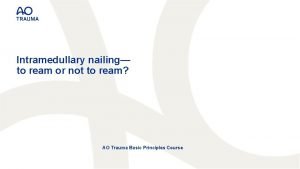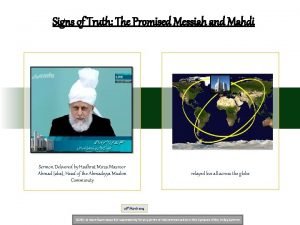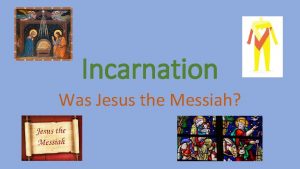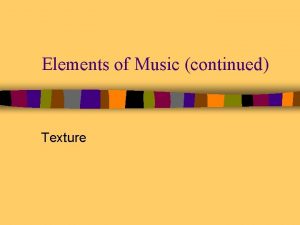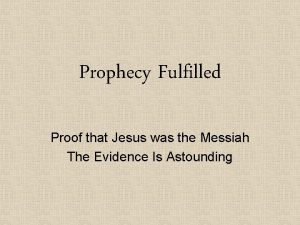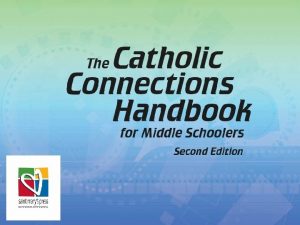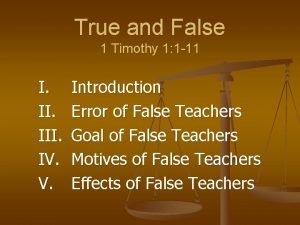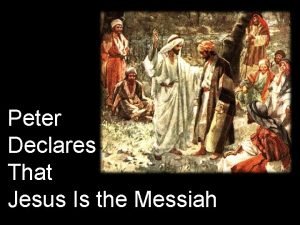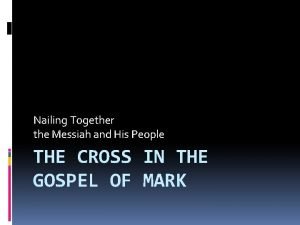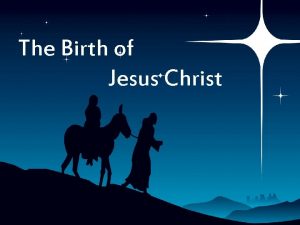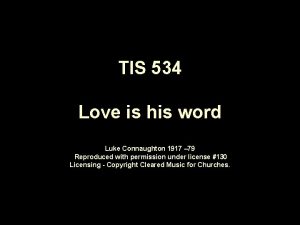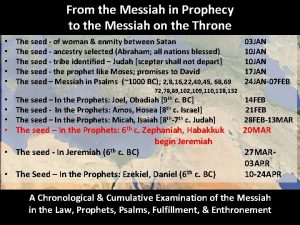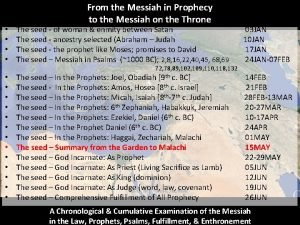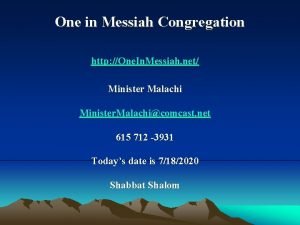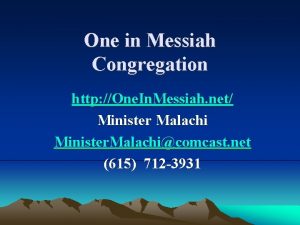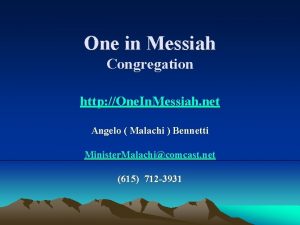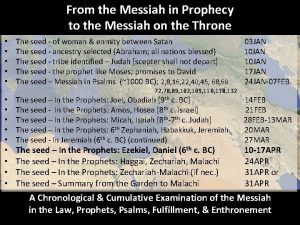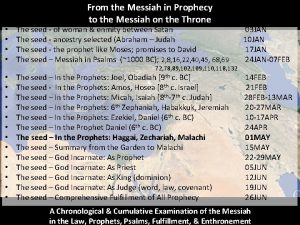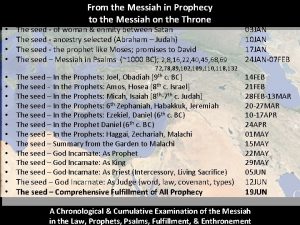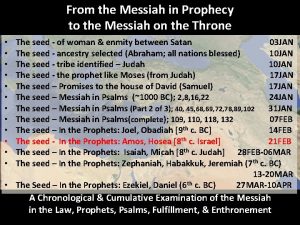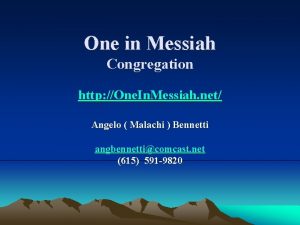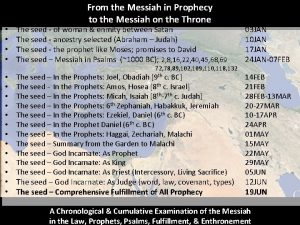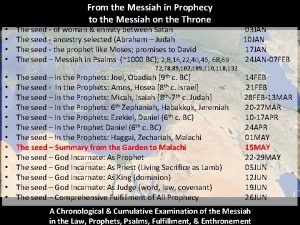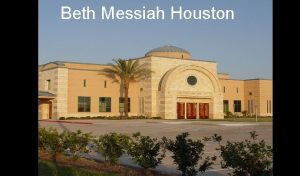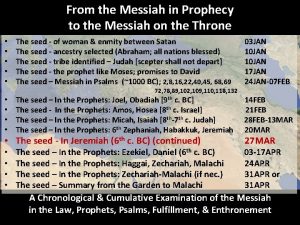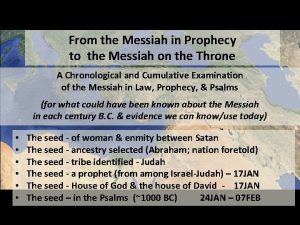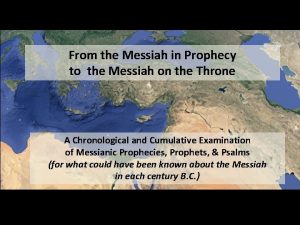Nailing Together the Messiah and His People THE
























































- Slides: 56

Nailing Together the Messiah and His People THE CROSS IN THE GOSPEL OF MARK

Rationale and Approach A topic with the word ‘cross’ in it usually ends up discussing Jesus’ death in general Of course, the fact that Jesus died for us, regardless of how it took place, is already profound and significant But was earliest Christianity indifferent to the mode of Jesus’ death? No. How Jesus died gave added meaning

Rationale and Approach Thus, we want to be precise and focus on stauros (English = cross) and its cognates We also want to see how the 1 st published Gospel treats this theme A further, pragmatic reason: not duplicating what other lecturers may be presenting Doing something not done before

Scope Background Statistics and Structure Thematic Tone Message

The Summum Supplicium BACKGROUND

Crucifixion in the 1 st Century Mediterranean World A barbaric and cruel form of execution Meant to prolong torture before death (physical) Meant to humiliate publicly (emotional) Meant to make a statement for the ruling power (mental) Serving as a strong deterrent

The Supreme Roman Penalty The three summa supplicia (supreme punishments) in ascending order (according to Cicero (1 st century BCE) and Julius Paulus (2 nd century CE)) Crux (Crucifixion) Crematio (Burning) Decollatio (Decapitation)

Who were subjected to crucifixion in the Roman Empire? Seditious foreigners and rebels Violent criminals Robbers Slaves (supplicium servile = punishment of slaves)

Crucifixion and Roman Citizens Rarely administered Confined to the humiliores (lower classes) For Treason Desertion to the enemy Incitements to rebellion Murder ‘Big’ crimes

Crucified Victims Often stripped totally bare Often not buried but became fodder for ravaging dogs or wild animals Proper burial was of utmost importance for ancients If this was respected, the most the Romans would do was to bury victims in mass graves

Crucifixion and the Jews If a man guilty of a capital offence Theological considerations moreand important than is put to death his body is political oneshung on a tree, you must not leave his body in onthe thelight treeofovernight. Interpreted crucifixion Deut 21. 23 -Be sure to bury him that same day, 24 because anyone who is hung on a Crucifixion = tree cursed God's and cut off from is by under curse. Youthe must community not desecrate the land the LORD your God is giving you as an Jews did adopt this practice in their internecine inheritance. conflict (AJ 13. 380 -3; BJ 1. 97 -8; m. Sanh 6. 5)

The Hard Data STATISTICS AND STRUCTURE

Statistics Doesn’t give the full picture But does give a picture none the less, and often, it is important.

Word Statistics Stauros (noun) Mark 4 X NT 27 X (Matt 5 X, Luke 3 X, John 4 X, Paul 10 X) Stauroō (verb) Mark 8 X NT 46 X (Matt 10 X, Luke 6 X, John 11 X, Paul 8 X) Systauroō (verb) Mark 1 x (15. 32) NT 5 X (Matt 27. 44; John 19. 32; Rom 6. 6; Gal 2. 19)

Mark’s Use of Stauros (4 X) vs Other Gospels All paralleled in Matthew, sometimes in Luke Mark 8. 34 ||Matt 16. 24 ||Luke 9. 23 Mark 15. 21 || Matt 27. 32 || Luke 23. 26 Mark 15. 30 || Matt 27. 40 Mark 15. 32 || Matt 27. 42 John 19. 17, 19, 25, 31 Crucifixion Scene Discipleship Theme Matt 10. 38 || Luke 14. 27

Observations 2 settings for the use of stauros (noun) Predominantly for the crucifixion scene (to be expected). This is true for all of John’s usage. Discipleship (this is also true for Matthew and Luke; the saying is similar) The first occurrence of the word is found in a discipleship context

Mark’s Use of Stauroō (8 X) 7 times in Mark 15. 13 -27 (trial and crucifixion scenes) First two occurrences: the cry of the crowds! Once in Mark 16. 6 (resurrection scene): ton estaurōmenon: an attributive participle (only occurrence) All paralleled, except once: Mark 15. 25 Systauroō (co-crucified) used once in Mark 15. 32 || Matt 27. 44 NT 5 X (Mark 1 X, Matt 1 X, John 1 X (19. 32), Paul 2 X = Rom 6. 6; Gal 2. 19)!

Observations All found in the trial and crucifixion scenes (to be expected), except 1 Mark 16. 6 Attributive Participle, ton estaurōmenon (the crucified one): i. e. used for definition All appropriated by other Gospel writers, except Mark 15. 25 Which speaks of the time of crucifixion Apparently contradicting the tradition found in John 19. 14 -16

Structure All coming after Peter’s confession in Mark 8. 31 Peter’s confession, a high watermark in Mark’s Gospel 1 st time Jesus spoke plainly about his death, in response to Peter’s confession, although death has been alluded to earlier (2. 20; 3. 6). The mode of death is not stated, but alluded to in the sayings that follow

Structure Implication Turning point in the Gospel Jesus’ indomitable march, as Messiah, to Jerusalem Lessons on discipleship Cross connects Messiah and people The statistics supports this Cross defines Messiah Cross defines discipleship

Mark’s Theologia Crucis THEMATIC TONE

Preview First Salvo (Mark 8. 34) Passion Narrative Third Hour Last Shot (Mark 15. 25) (Mark 16. 6)

Mark 8. 34 as 1 st Salvo! First Salvo (Mark 8. 34) Importance of first impression, setting thematic tone First salvo is about discipleship, i. e. how the cross relates to Jesus’ followers. Using the cross to define discipleship

Mark 8. 34 and the Preceding Text Cluster of sayings on discipleship are made in response to Peter’s objection, which in turn was a response to Jesus’ explicit revelation of the nature of messianic vocation Point? The Messiah mustn't suffer! Clash of perspectives! Human vs divine

Cross in Mark 8. 34 The inclusio: ‘come after me’, and ‘follow me’ The same verb in Greek: akoloutheō The sandwiched items define what this means Picture language Serving as reference point Prompting creative reflection The key to understanding what following Jesus means Language drawn from a frightening reality

Taking Up the Cross The patibulum (cross-beam) To be raised on the stipes (upright beam) Carrying one’s own tool of execution The death march This dovetails with Jesus’ messianic vocation

The Sayings That Follow All about life and death (vv. 35 -37) To lose life is to gain life Qualified by ‘for Jesus’ sake’ and ‘the gospel’s sake’. Counsel given: weigh your life with what the world can offer, and see that the former outweighs the latter The eschatological warning: Jesus will come again, vindicated and glorified (v. 38)

Cross in Mark’s Passion Narrative First two uses of the verb stauroō (verb) are found on the lips of the crowds, demanding Jesus to be crucified (15. 13 -14) Pilate gave in (15. 15): 3 rd use of the verb

Cross in Mark’s Passion Narrative The preponderance of the stauros word group suggests emphasis Crucifixion is highlighted as the mode of Jesus’ death This is so because of its repulsive idea The Messiah, the Blessed One, is tortured, humiliated, cursed and becomes a pathetic picture of Roman triumph. Simon of Cyrene carries cross for Jesus (15. 21)

The Cross and Simon of Cyrene an important city in Cyrenaica (modern Libya) The name is Jewish The mention of his sons, Alexander and Rufus, suggests that the family was known to the Church, as members A picture of discipleship? He was ‘following Jesus’ He was carrying a cross: Jesus’ cross!

Conclusions about the Cross in Mark’s Passion Narrative The crowd’s request starts the ball rolling … It is emphasised that Jesus is crucified. Implication: disciples are to take up the cross but the one who is crucified first, and faced the brunt most, is Jesus! The action of Simon of Cyrene prompts theological reflection on discipleship

Mark 15. 25 and Time Third Hour (Mark 15. 25) Narrative time slows down in the Passion Narrative. It slows even more in chapter 15, especially at the crucifixion scene 5 time notes given: Daybreak: delivery to Pilate (v. 1) 3 rd hour: crucifixion (v. 25) 6 th hour: darkness over the land (v. 33) 9 th hour: cry of dereliction (v. 34) Evening: Burial (v. 42)

John 19. 14 -16 was the day of Preparation of At the Passover hour, Jesus was handed be Week, about the over sixthto hour. crucified "Here is your king, " Pilate said to the Jews. But 6 they Was 15 this a. m. ? shouted, "Take him away! Crucify(Greek him!"="Shall I crucify But cf. 18. 28: at daybreak prōi) Jesus was your king? " Pilate asked. to "We have no brought from Caiaphas’s residence see Pilate the Gospels. chief priests Datum king found but also Caesar, " in the Synoptic 16 Finally Pilate handed him answered. More probably, 12 noon. Note the participation of over to them to Note be crucified. the crowds (crucify him!). also 1. 39. So the soldiers took charge of Jesus. 6 th 14 It

Matthew and Luke Mark 15. 25 not found in Matthew and Luke. They followed Mark in the main, but stopped short of incorporating this. Why? They knew another tradition but respected Mark? It was deemed an inconsequential detail? Some scholars suggest they were embarrassed by the detail, as 9 a. m. was too early for crucifixion

Whence the Discrepancy? Confusion over the Greek letters Γ (gamma = 3) and Ғ (digamma = 6)? But this presupposes the two writers used a common Greek source. Rough approximations? John’s theological interest? At noon of Preparation Day (cf. 19. 14) Jews stop work Houses cleansed of leaven Slaughtering of Paschal lambs begins Jesus as the true Paschal Lamb, sacrificed for us

Mark’s 3 rd Hour Reckoning from sunrise (cf. 15. 1: Greek prōi = ‘daybreak’) Thus, 3 rd hour = 9 a. m. A structured breaking down of the fateful day for easy memory (note Mark’s 5 time-notes). Cf. Matthew 20. 1 -8

The Tamid? Daily burnt offering Believed to make daily atonement for the nation Expenses defrayed by royalty. Once this became impossible, it was funded by the Temple Tax Point: Jesus’ death and the Temple Tax? Point: Jesus as the real atonement?

Other Possibilities? Connection with the famous 3 rd day, i. e. binding crucifixion with resurrection? Part of a chronological scheme For narratival purposes? To show that Jesus died atypically quickly? To show God’s orderly plan?

Last Shot & Definition Last Shot (Mark 16. 6) Jesus is defined now for the first time as ‘the crucified one’ (Mark 16. 6). There are many Jesuses, which one? So, this is clarified usually by referring to His patronym (e. g. ‘Jesus, son of so-and-so’): not mentioned Or his domicile, i. e. toponym (e. g. ‘Jesus of Nazareth’): mentioned but deemed insufficient Supplemented by ‘the crucified one’

Last Shot and Definition The upshot is that the term ‘the crucified one’ was used not just because it made important sense to the women, but also for explication of a very profound aspect of Jesus’ identity. But note: this crucified one is also described as risen from the dead.

The Crucified One At the end of Mark’s narrative, Jesus may now be known as the crucified one. What Jesus expected of the disciples, he has himself drunk it to the very dregs. He was not just repudiated or executed like a common man. He had died the death of a rebel or a slave This, however, must be understood in tandem with his resurrection

Summary The cross: a summum supplicium (supreme punishment) and a supplicium servile (punishment of slaves) To define messianic vocation and discipleship To bind together Messiah and people

The Crux Interpretum of God and Life MESSAGE

What’s the Point? Divine transformation What terrified the Roman world is transmuted into an instrument of redemption Divine definition Of Messiah Of People Of Himself Divine love

Who is Jesus? The authentic Messiah who was crucified Through so doing, the standard way of understanding messiahship is given a seismic twist (cf. Mark 15. 39; Rev 5) He came to serve (or be a slave!) and not to be served (Mark 10. 45) This is all part of God’s redemptive plan

How should we then live? Nailing together the Messiah and his people (cf. Romans 6) Discipleship means following the crucified Messiah This means Doing our ‘life sums’ properly; and Embracing the Messiah’s cruciform paradigm

Who is God? But if it was God’s plan for his Messiah to be crucified, and if God was in the Messiah reconciling the world to himself (ample evidence in Mark, but cf. 2 Cor 5. 21), what sort of God do we, then, have?

The Crucified God The God who saves not by waving a magic wand, but drinking the cup of suffering and evil to its very dregs. So we find in a very profound way that when we are nailed with the Messiah, we are also nailed with God. We will give Mark’s one-time missionary companion the last word, mediated to us by one of his interpreters

Insights from C. K. Barrett (1) Paul preached the crucified Christ. Why crucified? Even if his hearers did not understand the meaning of Christos they knew very well the meaning of estaurōmenos. It meant that person was either a slave who had made his master unusually angry, or a political or military rebel. If Paul was unwilling to accept any of these explanations he must provide another …

Insights from C. K. Barrett (2) … We note here questions both historical and theological. Why did they kill [Christ]? That is a hard question for the historian. Why did God allow him to die? For theologian this is an even harder question … It is a hard enough question when we ask, Why do the innocent suffer? But this is not an event that God permitted; it was God himself who caused it. ‘God did not spare his own Son’ (Rom 8. 32). Isaac might come out of his ordeal whole, but not Jesus.

Insights from C. K. Barrett (3) If this tells us anything about God, does it tell us that he is a monster? Certainly not; but what then? It must say something about the complexity of the being of God – at least … about God’s twofoldness, for if the Crucified is not somehow God, as his Father also is, then the Father is inflicting suffering on an inferior – and this is monstrous …

Insights from C. K. Barrett (4) … simply to tell the story of the Cross poses all the questions about God … The Cross questions all conventional philosophical arguments, including the traditional Christian arguments, for the existence of God. The philosophical problem of verification is a real one, and the Cross means that God refuses to verify himself, to come down from the Cross and so to prove his case.

Insights from C. K. Barrett (5) It contradicts the cosmological and the teleological proof, for there is no event so disorderly, none that runs more plainly contrary to the notion of purpose in the ordering of the universe. It is the contradiction of the moral argument too …

Insights from C. K. Barrett (6) It is not easy to believe in God. That is why Christian thought about God does not begin with Plato and Aristotle, with the consideration of creation (cosmology) or the consideration of history (teleology), but with the preaching of the Cross. It is in the obedience of Jesus that God is known, in the suffering of Jesus that God is glorified. Every other god is an idol …

Insights from C. K. Barrett (7) … We can never be content with a god who wound up this watch of a universe and left it to tick. We need a God who wrestles with rebellion and overcomes resistance with love, a God who speaks in language that we can understand, because we see him in one who would rather be the friend of sinners and die than give them up and live.

In the Cross of Christ I Glory In the cross of Christ I glory, Towering o’er the wrecks of time; All the light of sacred story Gathers round its head sublime. Bane and blessing, pain and pleasure By the cross are sanctified; Peace is there that knows no measure. Joys that through all time abide. John Bowring
 Reamed and unreamed nail
Reamed and unreamed nail Signs of the promised messiah
Signs of the promised messiah The messiah
The messiah Wanted messiah poster
Wanted messiah poster Imitative polyphony
Imitative polyphony Proof jesus is the messiah
Proof jesus is the messiah Messiah definiton
Messiah definiton 2 timothy 1:9 predicts the coming messiah. true false
2 timothy 1:9 predicts the coming messiah. true false Peter declares that jesus is the messiah
Peter declares that jesus is the messiah Messiah college canvas
Messiah college canvas Stauros meaning
Stauros meaning Address with suite number example
Address with suite number example Marco koper
Marco koper Difference of people as media and people in media
Difference of people as media and people in media People living in a community
People living in a community Eight dollars the price of a movie these days
Eight dollars the price of a movie these days Cyrus the great held his growing empire together by
Cyrus the great held his growing empire together by How did chandragupta hold his vast empire together
How did chandragupta hold his vast empire together Where is the love lyrics 2016
Where is the love lyrics 2016 Quiz 1: glorious christ and his people
Quiz 1: glorious christ and his people An individual who stomps angrily out of a restaurant
An individual who stomps angrily out of a restaurant Act 1 scene 4 macbeth analysis
Act 1 scene 4 macbeth analysis Mi nombre sandra cisneros
Mi nombre sandra cisneros Metaphor in caged bird
Metaphor in caged bird Transformed people transform people
Transformed people transform people People just people
People just people Dug in behind enemy lines
Dug in behind enemy lines Baking bread endothermic or exothermic
Baking bread endothermic or exothermic He his money. so he can't buy his hamburger
He his money. so he can't buy his hamburger A salaried worker in the guild system
A salaried worker in the guild system Friars differed from other monks in that they
Friars differed from other monks in that they Love is his way
Love is his way Hát kết hợp bộ gõ cơ thể
Hát kết hợp bộ gõ cơ thể Ng-html
Ng-html Bổ thể
Bổ thể Tỉ lệ cơ thể trẻ em
Tỉ lệ cơ thể trẻ em Gấu đi như thế nào
Gấu đi như thế nào Tư thế worm breton là gì
Tư thế worm breton là gì Hát lên người ơi
Hát lên người ơi Các môn thể thao bắt đầu bằng tiếng chạy
Các môn thể thao bắt đầu bằng tiếng chạy Thế nào là hệ số cao nhất
Thế nào là hệ số cao nhất Các châu lục và đại dương trên thế giới
Các châu lục và đại dương trên thế giới Công thức tiính động năng
Công thức tiính động năng Trời xanh đây là của chúng ta thể thơ
Trời xanh đây là của chúng ta thể thơ Mật thư anh em như thể tay chân
Mật thư anh em như thể tay chân 101012 bằng
101012 bằng độ dài liên kết
độ dài liên kết Các châu lục và đại dương trên thế giới
Các châu lục và đại dương trên thế giới Thể thơ truyền thống
Thể thơ truyền thống Quá trình desamine hóa có thể tạo ra
Quá trình desamine hóa có thể tạo ra Một số thể thơ truyền thống
Một số thể thơ truyền thống Cái miệng xinh xinh thế chỉ nói điều hay thôi
Cái miệng xinh xinh thế chỉ nói điều hay thôi Vẽ hình chiếu vuông góc của vật thể sau
Vẽ hình chiếu vuông góc của vật thể sau Biện pháp chống mỏi cơ
Biện pháp chống mỏi cơ đặc điểm cơ thể của người tối cổ
đặc điểm cơ thể của người tối cổ Giọng cùng tên là
Giọng cùng tên là Vẽ hình chiếu đứng bằng cạnh của vật thể
Vẽ hình chiếu đứng bằng cạnh của vật thể
